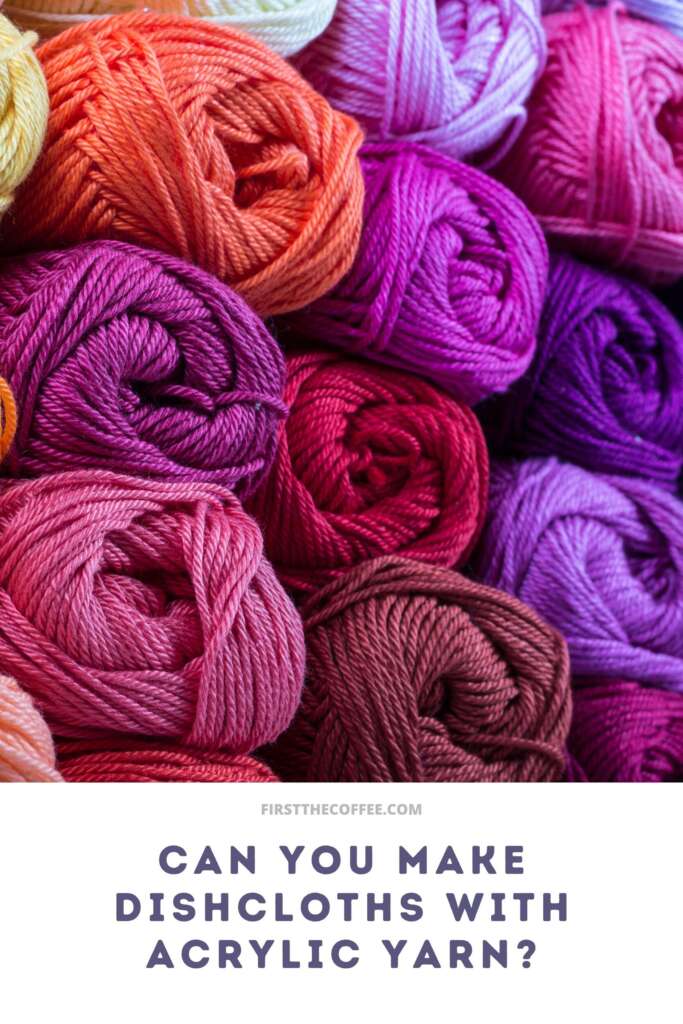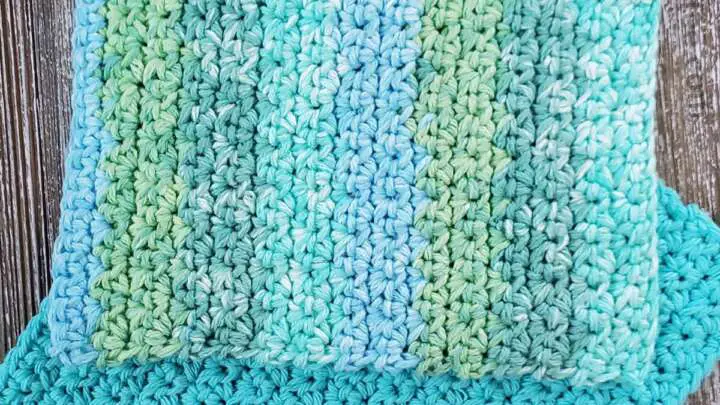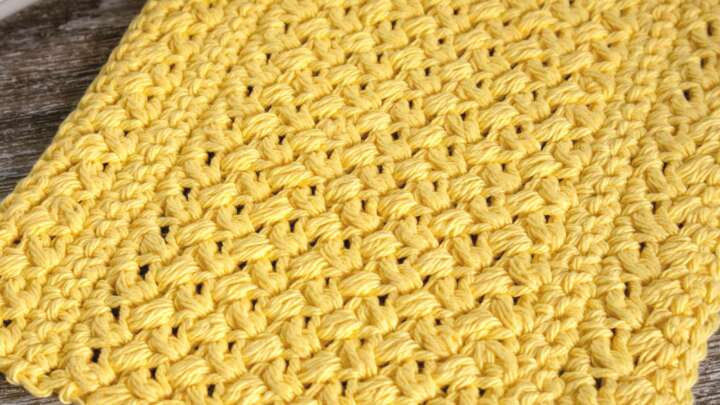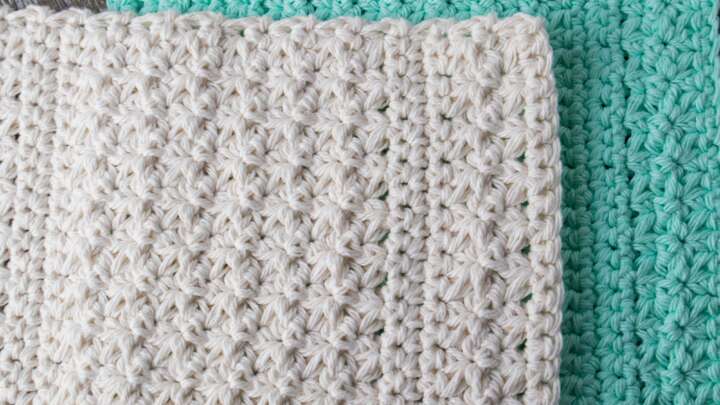Can you use acrylic yarn to crochet or knit dishcloths? Yes, you can make dishcloths with acrylic yarn, BUT! And there is a BIGGG BUT here: there are a few things to consider when deciding if it’s the best choice of yarn for making a dishcloth.
In my experience, cotton is king when crocheting dishcloths if the intent is to use them to clean with. Acrylic yarn just leaves a lot to be desired for the functionality when stitching up a dishcloth that you are going to be using in the kitchen or bathroom.
Things To Consider When Picking Out Yarn For Crocheting Dishcloths (Or Knitting!):
Of course, crocheters and knitters are going to have their own opinion on these factors, but this is just what I’ve come across when making things to use around the house for cleaning.
If you want the TL;DR: Cotton is a better choice all around when it comes to yarn for a dishcloth:)
Absorbency: Acrylic yarn is not as absorbent as natural fibers like cotton yarn.
A dishcloth made from acrylic yarn does not soak up water and spills as effectively as one made from more absorbent yarns, such as cotton or a cotton/polyester mix.
Also cleaning things up, such as grease, just doesn’t work well with fabric pieces made with acrylic yarn.
Durability: Acrylic yarn is durable and can withstand machine washing. (Also be sure to see the Eco-friendliness section down below for more consideration about washing acrylic yarn)
Drying can be a bit tricky. Most acrylic yarns can withstand the dryer, but on occasion, there can still be some issues with some acrylics and the heat of a dryer. Dishcloths need to be washed frequently, so this will be a big factor in what yarn to use.
Ability to Dry: If you’re using dishcloths for cleaning around the house or even the dishes themselves, you might be leaving your dishcloth sitting by the sink to dry.
Some people say that acrylic dries faster for them, while other people say cotton is faster at drying. This is going to be a personal preference and could possibly depend on your environment.
For me personally, when hanging my dishcloths up to dry, cotton always seems to dry faster than acrylic. Even though acrylic isn’t as absorbent for me, it seems like what water it does soak up it doesn’t want to let go of that moisture.
Heat resistance: Many people often wonder if acrylic yarn is heat resistant. Acrylic yarn is not as heat resistant as natural fibers. When exposed to high heat, it can melt or become damaged. So if you do decide to make one from acrylic yarn, do not ever use it as a hot pad.
Eco-friendliness: Acrylic yarn is a synthetic polymer material, it’s basically plastic.
Not only is there the manufacturing process of the yarn to consider if the environment is a concern of yours, but there is also the impact of washing the material. According to a study in 2016, acrylic releases the most synthetic materials when washed in a washing machine. The Guardian has an informative article on it if you want to read more: Single clothes wash may release 700,000 microplastic fibres.
If you’re looking for an eco-friendly option when it comes to using yarn for your crochet projects, consider using natural fibers such as cotton or linen. But many cotton yarns are blended with polyester, which is also synthetic, so it can narrow down your choices of yarn for a dishcloth if you are trying to stay 100% natural.
Sensory Issues: If you are like me, the feeling of some things can make your skin crawl. And wet acrylic yarn is one of those things for me. Dry acrylic can be scratchy enough on my skin (I am super picky about the acrylic I use), add water and it is exponentially magnified. Its like nails on a chalkboard for me. If I had a dishcloth made from acrylic yarn, there is no way personally I could touch the dishcloth after it got wet. And I’m sure there are others out there who would have the same issue.
Colorfastness: Dishcloths are exposed to water and cleaning solutions, so it’s essential to choose a yarn that is colorfast and resistant to fading and bleeding dye. Look for yarns that have been treated for colorfastness. One thing I have found is that with many cotton yarns, the darker the color the higher the likelihood that it will bleed its color. So if you don’t want to use light-colored yarn due to staining from cleaning, try not to use something that is very dark either.
Cleaning Chemicals: If you use bleach products frequently, this can affect any dishcloth you make no matter what the material is. But cotton in white or off-white color won’t be affected as much.
So, while it is possible to make dishcloths with acrylic yarn, they are not going to perform as well as those made from natural fiber yarn.
Cotton yarn, particularly, is a popular choice for dishcloths due to its absorbency, durability, and heat resistance. And cotton yarn is my #1 choice when it comes to making my own crochet dishcloths.
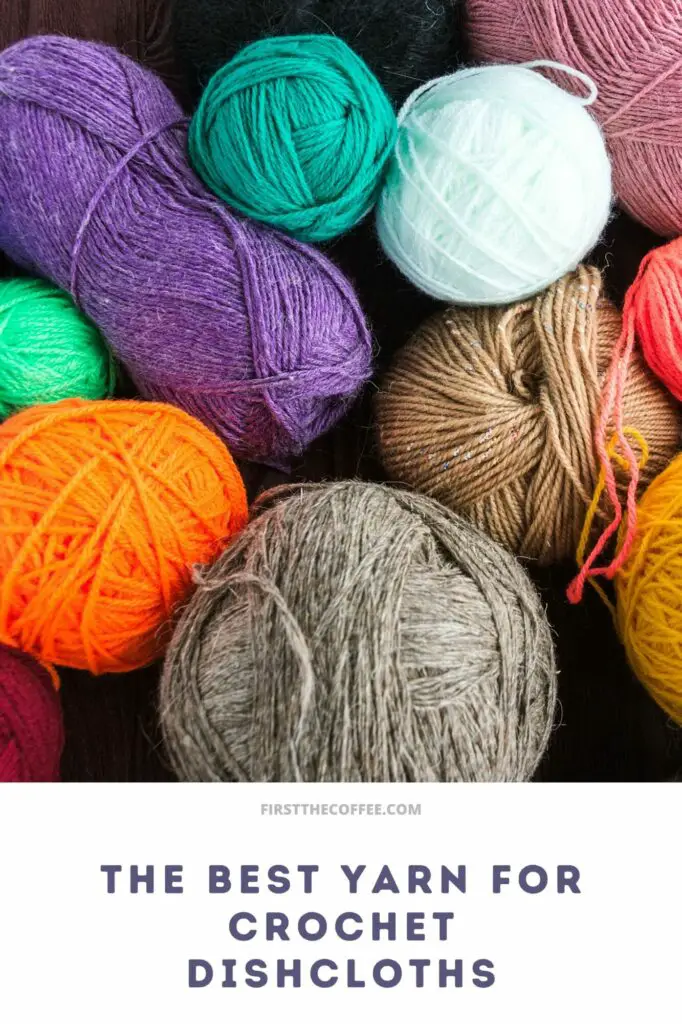
Please note that this post may contain affiliate links. You can read my full affiliate disclosure at the bottom of the page.
What Kind of Yarn Do You Use for Dishcloths?
I always use a cotton based yarn for my crochet dishcloths, washcloths, and dishtowels. This gives me the best absorbency and ability to scrub debris and grime off dishes and other things that need cleaning with them.
Bamboo blends are also another option that can be used, but cotton is my go-to yarn for making dishcloths.
Best Brand of Cotton Yarn for Crochet Dishcloths
My favorite top 3 brands of cotton yarn to use when I make my own crochet dishcloths are:
I like these three cotton yarns the best due to the quality and cost. The Eco Cotton and Premier Home are the cheapest of the 3, and Lily’s Sugar & Cream is just a tad bit higher in price.
If I need something that is stiffer and more abrasive and that needs to be 100% cotton, then I’ll pick the Lily’s Sugar & Cream yarn, otherwise, I’ll pick one of the other two brands. The Loops & Thread Capri Eco Cotton and the Premier Home Cotton are both 85% Recycled Cotton and 15% Polyester, this makes both of these brands much softer to the touch.
There are some other brands that are also good, but the price point on them keeps me from using them too often. One is Lion Brand’s Pima Cotton. If I pick this one it is because I need it to match something that I’m already using that yarn for.
What Weight Yarn Should You Use for Dishcloths?
Medium-weight worsted yarn is the best yarn weight to use for dishcloths. And it is the most common weight of yarn that you will find cotton yarns in. While DK weight is available in cotton, the dishcloth would wind up being very thin and delicate. So worsted weight is best for the thickness and durability of a dishcloth.
DIY Crochet Dishcloth Patterns
If you're looking for some dishcloth patterns to crochet yourself, we have quite a few available for free:

